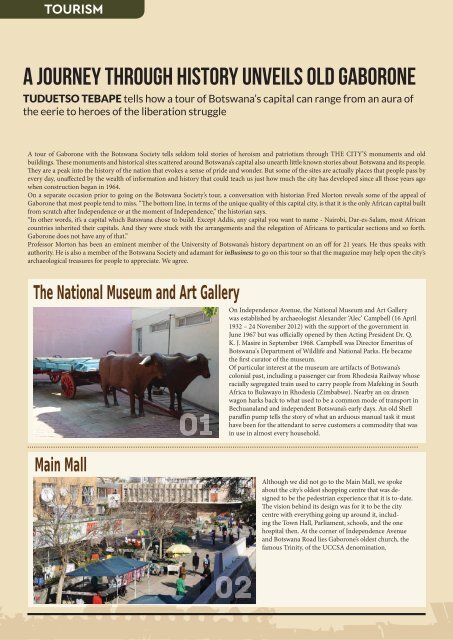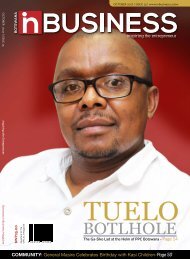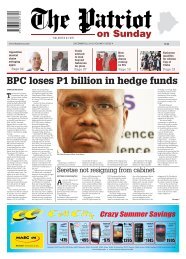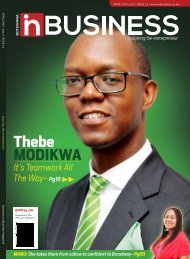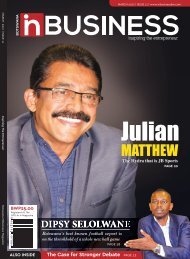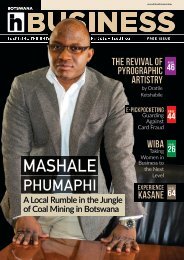inBUSINESS Issue 12
Create successful ePaper yourself
Turn your PDF publications into a flip-book with our unique Google optimized e-Paper software.
TOURISM<br />
A Journey Through History Unveils Old Gaborone<br />
TUDUETSO TEBAPE tells how a tour of Botswana’s capital can range from an aura of<br />
the eerie to heroes of the liberation struggle<br />
A tour of Gaborone with the Botswana Society tells seldom told stories of heroism and patriotism through THE CITY’S monuments and old<br />
buildings. These monuments and historical sites scattered around Botswana’s capital also unearth little known stories about Botswana and its people.<br />
They are a peak into the history of the nation that evokes a sense of pride and wonder. But some of the sites are actually places that people pass by<br />
every day, unaffected by the wealth of information and history that could teach us just how much the city has developed since all those years ago<br />
when construction began in 1964.<br />
On a separate occasion prior to going on the Botswana Society’s tour, a conversation with historian Fred Morton reveals some of the appeal of<br />
Gaborone that most people tend to miss. “The bottom line, in terms of the unique quality of this capital city, is that it is the only African capital built<br />
from scratch after Independence or at the moment of Independence,” the historian says.<br />
“In other words, it’s a capital which Batswana chose to build. Except Addis, any capital you want to name - Nairobi, Dar-es-Salam, most African<br />
countries inherited their capitals. And they were stuck with the arrangements and the relegation of Africans to particular sections and so forth.<br />
Gaborone does not have any of that.”<br />
Professor Morton has been an eminent member of the University of Botswana’s history department on an off for 21 years. He thus speaks with<br />
authority. He is also a member of the Botswana Society and adamant for inBusiness to go on this tour so that the magazine may help open the city’s<br />
archaeological treasures for people to appreciate. We agree.<br />
The National Museum and Art Gallery<br />
01<br />
On Independence Avenue, the National Museum and Art Gallery<br />
was established by archaeologist Alexander ‘Alec’ Campbell (16 April<br />
1932 – 24 November 20<strong>12</strong>) with the support of the government in<br />
June 1967 but was officially opened by then Acting President Dr. Q.<br />
K. J. Masire in September 1968. Campbell was Director Emeritus of<br />
Botswana's Department of Wildlife and National Parks. He became<br />
the first curator of the museum.<br />
Of particular interest at the museum are artifacts of Botswana’s<br />
colonial past, including a passenger car from Rhodesia Railway whose<br />
racially segregated train used to carry people from Mafeking in South<br />
Africa to Bulawayo in Rhodesia (Zimbabwe). Nearby an ox drawn<br />
wagon harks back to what used to be a common mode of transport in<br />
Bechuanaland and independent Botswana’s early days. An old Shell<br />
paraffin pump tells the story of what an arduous manual task it must<br />
have been for the attendant to serve customers a commodity that was<br />
in use in almost every household.<br />
Main Mall<br />
Although we did not go to the Main Mall, we spoke<br />
about the city’s oldest shopping centre that was designed<br />
to be the pedestrian experience that it is to-date.<br />
The vision behind its design was for it to be the city<br />
centre with everything going up around it, including<br />
the Town Hall, Parliament, schools, and the one<br />
hospital then. At the corner of Independence Avenue<br />
and Botswana Road lies Gaborone’s oldest church, the<br />
famous Trinity, of the UCCSA denomination.<br />
02<br />
32<br />
www.inbusiness.co.bw | <strong>Issue</strong> <strong>12</strong> | 2017


